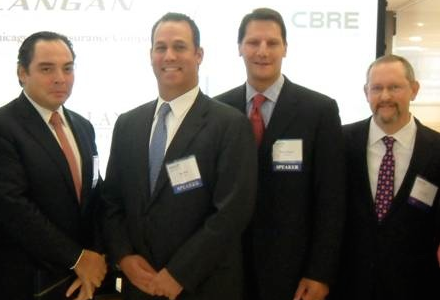
|
Everyone wants to invest in NYC commercial real estate (the Mets won’t spend on a shortstop unless he’s also an office tower). There’s no sweeter time in history than now for Bisnow to host its NYC Capital Markets Summit, happening April 9 (sign up). In advance of the event, we asked a few heavy-hitter capital markets guys how to achieve returns in this heady market. 1) Be patient and carry a big stick
RXR president Michael Maturo (second from right), one of the panelists at our event, says his company, a NYC metro-only investor, is willing to wait more than a year to get into an asset, while other bidders likely will have moved on. It first got involved in 470 Lex in 2010, for instance, taking the junior mezz position. Next came the senior mezz, and nine months later in fall 2012, RXR became sole owner (for $300M) of the 920k SF tower next to Grand Central. The company had stayed with the owner through some troubles until he was ready to sell, Michael says. He’s pictured with 60 Guilders’Kevin Chisholm, SL Green co-chief investment officer Isaac Zion, also a panelist, and JLL’s Jon Caplan. 2) Get in front of growth markets
RXR also puts itself in the path of trending growth, Michael tells us. The company got into Midtown South early with the 2.3M SF Starrett-Lehigh Building and Flatiron’s 700k SF 620 Ave of the Americas (which you know as TJ Maxx and Marshalls). Most recently, that frontier spirit took RXR to Brooklyn, where in February, it paid $200M for the leasehold for the 750k SF 470 Vanderbilt near Barclays Center (above). The company is leasing the 75k SF of vacant office now and is letting the submarket evolve just a tad more as it thinks through a long-term program for the 30k SF of retail. 3) Use less debt than everyone elseWhen interest rates are low, lever on up, right? Bauhouse Group principal Joe Beninati, whom we snapped yesterday, has a different view. Joe, who co-founded Bauhouse with Chris Jones and Danny Lee, is playing it safe with lower leverage: 58% to 63% while everyone else is going 65% to 75% (high leverage didn’t work out well during the recession for Joe’s Connecticut-focused Antares Investment). On a $100M deal, the lower leverage would mean justanother $5M in equity, he says, and in exchange, Bauhouse would be more likely to be able to restructure if it runs into distress or the market crashes. Joe and partners are building $100M of retail and condos at 515 W 29th St (which we snapped this morning, below). They closed two weeks ago on the three pieces of air rights to give the project a go-ahead, the first property to be bordered by the High Line on two sides (as he illustrated for us above—though that’s also a line graph of our March Madness success). He’ll also hold the 5,000 SF of retail long term. It’s a Warren Buffett play, he says: Don’t avoid taxes, just deferthem. Once he’s held the retail unit (or held condo units to rent them out) for 366 days, the tax he pays on his return drops from 45% ordinary income tax to 25% capital gains tax. Joe tells us Bauhouse is likely to close on two residential/retail sites inearly May, one about the same size as the High Line project and one three times as big. He’s also looking into a Washington Heightsdevelopment site for apartments, and he thinks the Bronx (his home borough; he grew up near Pelham Bay) is mispriced relative to Brooklyn. Sure, Brooklyn is trendy, but Bronx land costs $50/SF compared to Brooklyn’s $500k. |